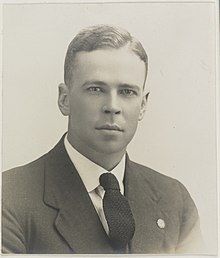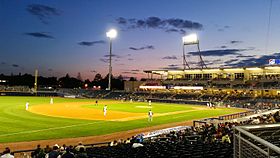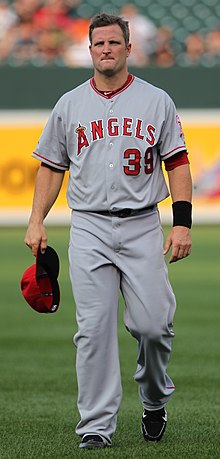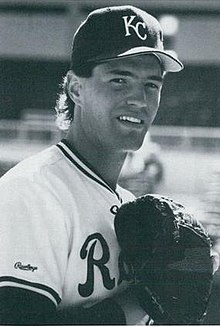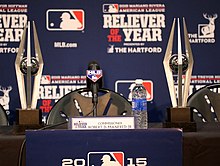Portal:Baseball
Portal maintenance status: (June 2018)
|
| Main page | Content, Categories & Topics | WikiProjects & Things you can do |
The Baseball Portal
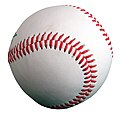
Baseball is a bat-and-ball sport played between two teams of nine players each, taking turns batting and fielding. The game occurs over the course of several plays, with each play generally beginning when a player on the fielding team, called the pitcher, throws a ball that a player on the batting team, called the batter, tries to hit with a bat. The objective of the offensive team (batting team) is to hit the ball into the field of play, away from the other team's players, allowing its players to run the bases, having them advance counter-clockwise around four bases to score what are called "runs". The objective of the defensive team (referred to as the fielding team) is to prevent batters from becoming runners, and to prevent runners advancing around the bases. A run is scored when a runner legally advances around the bases in order and touches home plate (the place where the player started as a batter).
The opposing teams switch back and forth between batting and fielding; the batting team's turn to bat is over once the fielding team records three outs. One turn batting for each team constitutes an inning. A game is usually composed of nine innings, and the team with the greater number of runs at the end of the game wins. Most games end after the ninth inning, but if scores are tied at that point, extra innings are usually played. Baseball has no game clock, though some competitions feature pace-of-play regulations such as the pitch clock to shorten game time.
Baseball evolved from older bat-and-ball games already being played in England by the mid-18th century. This game was brought by immigrants to North America, where the modern version developed. Baseball's American origins, as well as its reputation as a source of escapism during troubled points in American history such as the American Civil War and the Great Depression, have led the sport to receive the moniker of "America's Pastime"; since the late 19th century, it has been unofficially recognized as the national sport of the United States, though in modern times is considered less popular than other sports, such as American football. In addition to North America, baseball spread throughout the rest of the Americas and the Asia–Pacific in the 19th and 20th centuries, and is now considered the most popular sport in parts of Central and South America, the Caribbean, and East Asia, particularly in Japan, South Korea, and Taiwan. (Full article...)
 Featured articles - load new batch
Featured articles - load new batch
-
Image 1Advertisement in Billboard magazine in 1907
How Brown Saw the Baseball Game is an American short silent comedy film produced in 1907 and distributed by the Lubin Manufacturing Company. The film follows a baseball fan named Mr. Brown who overdrinks before a baseball game and becomes so intoxicated that the game appears to him in reverse motion. During production, trick photography was used to achieve this effect. The film was released in November 1907. It received a positive review in a 1908 issue of The Courier-Journal that reported the film was successful and "truly funny". As of 2021[update], it is unclear whether the print of the film has survived. The identities of the film cast and production crew are unknown. Film historians have noted similarities between the plot of How Brown Saw the Baseball Game and How the Office Boy Saw the Ball Game. It is a comedy film directed by Edwin S. Porter, having released a year before How Brown Saw the Baseball Game. (Full article...) -
Image 2
Stanley Frank Musial (/ˈmjuːziəl, -ʒəl/; born Stanislaw Franciszek Musial; November 21, 1920 – January 19, 2013), nicknamed "Stan the Man", was an American baseball outfielder and first baseman. Widely considered to be one of the greatest and most consistent hitters in baseball history, Musial spent 22 seasons in Major League Baseball (MLB), playing for the St. Louis Cardinals, from 1941 to 1944 and from 1946 to 1963. He was inducted into the Baseball Hall of Fame in 1969 in his first year of eligibility.
Musial was born in Donora, Pennsylvania, where he frequently played baseball informally or in organized settings, and eventually played on the baseball team at Donora High School. Signed to a professional contract by the St. Louis Cardinals as a pitcher in 1938, Musial was converted into an outfielder and made his major league debut in 1941. Noted for his unique batting stance, he quickly established himself as a consistent and productive hitter. In his first full season, 1942, the Cardinals won the World Series. The following year, he led the NL in six different offensive categories and earned his first MVP award. He was also named to the NL All-Star squad for the first time; he appeared in every All-Star game in every subsequent season he played. Musial won his second World Series championship in 1944, then missed the 1945 season while serving in the Navy. After completing his military service, Musial returned to baseball in 1946 and resumed his consistent hitting. That year he earned his second MVP award and third World Series title. His third MVP award came in 1948, when he finished one home run short of winning baseball's Triple Crown. After struggling offensively in 1959, Musial used a personal trainer to help maintain his productivity until he decided to retire in 1963. (Full article...) -
Image 3Disco Demolition Night was a Major League Baseball (MLB) promotion on Thursday, July 12, 1979, at Comiskey Park in Chicago, Illinois, that ended in a riot. At the climax of the event, a crate filled with disco records was blown up on the field between games of the twi-night doubleheader between the Chicago White Sox and the Detroit Tigers. Many had come to see the explosion rather than the games and rushed onto the field after the detonation. The playing field was so damaged by the explosion and by the rioters that the White Sox were required to forfeit the second game to the Tigers.
In the late 1970s, dance-oriented disco was the most popular music genre in the United States, particularly after being featured in hit films such as Saturday Night Fever (1977). However, disco sparked a major backlash from rock music fans—an opposition prominent enough that the White Sox, seeking to fill seats at Comiskey Park during a lackluster season, engaged Chicago shock jock and anti-disco campaigner Steve Dahl for the promotion at the July 12 doubleheader. Dahl's sponsoring radio station was WLUP (97.9 FM, now WCKL), so admission was discounted to 98 cents for attendees who turned in a disco record; between games, Dahl was to destroy the collected vinyl in an explosion. (Full article...) -
Image 4
Marcus Elmore Baldwin (October 29, 1863 – November 10, 1929), nicknamed "Fido" and "Baldy", was an American professional baseball pitcher who played seven seasons in Major League Baseball (MLB). In 346 career games, he pitched to a 154–165 win–loss record with 295 complete games. Baldwin set the single-season MLB wild pitches record with 83 that still stands today.
Born in Pittsburgh, Pennsylvania, Baldwin made his professional debut for a Cumberland, Maryland, team in 1883. Though signed by Chicago White Stockings president Albert Spalding to pitch against the St. Louis Browns in the 1886 World Series, Baldwin did not play after the Browns objected. He made his MLB debut for the White Stockings in 1887, when a writer for the Oshkosh Daily Northwestern called him the "swiftest pitcher in the National League" (NL). Released by Chicago player–manager Cap Anson, he signed with the Columbus Solons of the American Association (AA) in 1889, where he led the league in innings pitched (513+2⁄3), losses (34), strikeouts (368), and walks (274). (Full article...) -
Image 5
James Francis Thorpe (Meskwaki: Wa-Tho-Huk, translated as "Bright Path"; May 22 or 28, 1887 – March 28, 1953) was an American athlete and Olympic gold medalist. A member of the Sac and Fox Nation, Thorpe was the first Native American to win a gold medal for the United States in the Olympics. Considered one of the most versatile athletes of modern sports, he won two Olympic gold medals in the 1912 Summer Olympics (one in classic pentathlon and the other in decathlon). He also played football (collegiate and professional), professional baseball, and professional basketball.
He lost his Olympic titles after it was found he had been paid for playing two seasons of semi-professional baseball before competing in the Olympics, thus violating the contemporary amateurism rules. In 1983, 30 years after his death, the International Olympic Committee (IOC) restored his Olympic medals with replicas, after ruling that the decision to strip him of his medals fell outside of the required 30 days. Official IOC records still listed Thorpe as co-champion in decathlon and pentathlon until 2022, when it was decided to restore him as the sole champion in both events. (Full article...) -
Image 6

Ian Michael Chappell (born 26 September 1943) is a former cricketer who played for South Australia and Australia. Known as "Chappelli", he is considered as one of the greatest captains the game has seen. He captained Australia between 1971 and 1975 before taking a central role in the breakaway World Series Cricket organisation. Born into a cricketing family—his grandfather and brother also captained Australia—Chappell made a hesitant start to international cricket playing as a right-hand middle-order batsman and spin bowler. He found his niche when promoted to bat at number three. Chappell's blunt verbal manner led to a series of confrontations with opposition players and cricket administrators; the issue of sledging first arose during his tenure as captain, and he was a driving force behind the professionalisation of Australian cricket in the 1970s. He was the captain of the Australian squad which finished as runners-up at the 1975 Cricket World Cup.
John Arlott called him "a cricketer of effect rather than the graces". An animated presence at the batting crease, he constantly adjusted his equipment and clothing, and restlessly tapped his bat on the ground as the bowler ran in. Basing his game on a sound defence learned during many hours of childhood lessons, Chappell employed the drive and square cut to full effect. He had an idiosyncratic method of playing back and across to a ball of full length and driving wide of mid-on, but his trademark shot was the hook, saying "three bouncers an over should be worth 12 runs to me". A specialist slip fielder, he was the fourth player to take one hundred Test catches. (Full article...) -
Image 7
Kenesaw Mountain Landis (/ˈkɛnɪsɔː ˈmaʊntɪn ˈlændɪs/; November 20, 1866 – November 25, 1944) was an American jurist who served as a United States federal judge from 1905 to 1922 and the first commissioner of baseball from 1920 until his death. He is remembered for his resolution of the Black Sox Scandal, in which he expelled eight members of the Chicago White Sox from organized baseball for conspiring to lose the 1919 World Series and repeatedly refused their reinstatement requests. His iron rule over baseball in the near quarter-century of his commissionership is generally credited with restoring public confidence in the game.
Landis was born in Millville, Ohio. Raised in Indiana, he became a lawyer, and then personal secretary to Walter Q. Gresham, the new United States Secretary of State, in 1893. He returned to private practice after Gresham died in office. (Full article...) -
Image 8
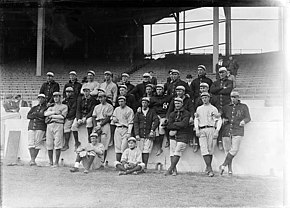
The 1913 squad, the first that went by the name "Yankees"
The history of the New York Yankees Major League Baseball (MLB) team spans more than a century. Frank J. Farrell and William Stephen Devery bought the rights to an American League (AL) club in New York City after the 1902 season. The team, which became known as the Yankees in 1913, rarely contended for the AL championship before the acquisition of outfielder Babe Ruth after the 1919 season. With Ruth in the lineup, the Yankees won their first AL title in 1921, followed by their first World Series championship in 1923. Ruth and first baseman Lou Gehrig were part of the team's Murderers' Row lineup, which led the Yankees to a then-AL record 110 wins and a Series championship in 1927 under Miller Huggins. They repeated as World Series winners in 1928, and their next title came under manager Joe McCarthy in 1932.
The Yankees won the World Series every year from 1936 to 1939 with a team that featured Gehrig and outfielder Joe DiMaggio, who recorded a record hitting streak during New York's 1941 championship season. New York set a major league record by winning five consecutive championships from 1949 to 1953, and appeared in the World Series nine times from 1955 to 1964. Mickey Mantle, Yogi Berra, and Whitey Ford were among the players fielded by the Yankees during the era. After the 1964 season, a lack of effective replacements for aging players caused the franchise to decline on the field, and the team became a money-loser for owners CBS while playing in an aging stadium. (Full article...) -
Image 9
William Harold Ponsford MBE (19 October 1900 – 6 April 1991) was an Australian cricketer. Usually playing as an opening batsman, he formed a successful and long-lived partnership opening the batting for Victoria and Australia with Bill Woodfull, his friend and state and national captain. Ponsford is the only player to twice break the world record for the highest individual score in first-class cricket; Ponsford and Brian Lara are the only cricketers to twice score 400 runs in an innings. Ponsford holds the Australian record for a partnership in Test cricket, set in 1934 in combination with Don Bradman (451 for 2nd wicket)—the man who broke many of Ponsford's other individual records. In fact, he along with Bradman set the record for the highest partnership ever for any wicket in Test cricket history when playing on away soil (451 runs for the second wicket)
Despite being heavily built, Ponsford was quick on his feet and renowned as one of the finest ever players of spin bowling. His bat, much heavier than the norm and nicknamed "Big Bertha", allowed him to drive powerfully and he possessed a strong cut shot. However, critics questioned his ability against fast bowling, and the hostile short-pitched English bowling in the Bodyline series of 1932–33 was a contributing factor in his early retirement from cricket a year and a half later. Ponsford also represented his state and country in baseball, and credited the sport with improving his cricketing skills. (Full article...) -
Image 10
Earvin "Magic" Johnson Jr. (born August 14, 1959) is an American businessman and former professional basketball player. Often regarded as the greatest point guard of all time, Johnson spent his entire career with the Los Angeles Lakers in the National Basketball Association (NBA). After winning a national championship with the Michigan State Spartans in 1979, Johnson was selected first overall in the 1979 NBA draft by the Lakers, leading the team to five NBA championships during their "Showtime" era. Johnson retired abruptly in 1991 after announcing that he had contracted HIV, but returned to play in the 1992 All-Star Game, winning the All-Star MVP Award. After protests against his return from his fellow players, he retired again for four years, but returned in 1996, at age 36, to play 32 games for the Lakers before retiring for the third and final time.
Known for his extraordinary court vision, passing abilities, and leadership, Johnson was one of the most dominant players of his era. His career achievements include three NBA Most Valuable Player Awards, three NBA Finals MVPs, nine All-NBA First Team designations, and twelve All-Star games selections. He led the league in regular season assists four times, and is the NBA's all-time leader in average assists per game in both the regular season (11.19 assists per game) and the playoffs (12.35 assists per game). He also holds the records for most career playoff assists and most career playoff triple-doubles. Johnson was the co-captain of the 1992 United States men's Olympic basketball team ("The Dream Team"), which won the Olympic gold medal in Barcelona; Johnson hence became one of eight players to achieve the basketball Triple Crown. After leaving the NBA in 1991, he formed the Magic Johnson All-Stars, a barnstorming team that traveled around the world playing exhibition games. (Full article...) -
Image 11The Nashville Sounds Minor League Baseball team was established in Nashville, Tennessee, in 1978, after Larry Schmittou and a group of investors purchased the rights to operate an expansion franchise of the Double-A Southern League. The Sounds played their home games at Herschel Greer Stadium from its opening in 1978 until the end of the 2014 season. In 2015, the Sounds left Greer for First Tennessee Park, now known as First Horizon Park, a new facility located on the site of the historic Sulphur Dell ballpark, home to Nashville's minor league teams from 1885 to 1963.
The Sounds led all of Minor League Baseball in attendance in their inaugural season and continued to draw the Southern League's largest crowds in each of their seven years as members of the league. On the field, the team won six consecutive second-half division titles from 1979 to 1984 and won the Southern League championship twice: in 1979 as the Double-A affiliate of the Cincinnati Reds and again in 1982 as the Double-A affiliate of the New York Yankees. (Full article...) -
Image 12
Mariano Rivera (born November 29, 1969) is a Panamanian-American former professional baseball pitcher who played 19 seasons in Major League Baseball (MLB) for the New York Yankees, from 1995 to 2013. Nicknamed "Mo" and "Sandman", he spent most of his career as a relief pitcher and served as the Yankees' closer for 17 seasons. A thirteen-time All-Star and five-time World Series champion, he is MLB's career leader in saves (652) and games finished (952). Rivera won five American League (AL) Rolaids Relief Man Awards and three Delivery Man of the Year Awards, and he finished in the top three in voting for the AL Cy Young Award four times. In 2019, he was inducted into the Baseball Hall of Fame in his first year of eligibility, and is to date the only player ever to be elected unanimously by the Baseball Writers' Association of America (BBWAA).
Raised in the modest Panamanian fishing village of Puerto Caimito, Rivera was an amateur player until he was signed by the Yankees organization in 1990. He debuted in the major leagues in 1995 as a starting pitcher, before permanently converting to a relief pitcher late that year. After a breakthrough season in 1996 as a setup man, he became the Yankees' closer in 1997. In the following seasons, he established himself as one of baseball's top relievers, leading the major leagues in saves in 1999, 2001, and 2004. Rivera primarily threw a sharp-moving, mid-90s mile-per-hour cut fastball that frequently broke hitters' bats and earned a reputation as one of the league's toughest pitches to hit. With his presence at the end of games, signaled by his foreboding entrance song "Enter Sandman", Rivera was a key contributor to the Yankees' dynasty in the late 1990s and early 2000s that won four championships in five years. He was an accomplished postseason performer, winning the 1999 World Series Most Valuable Player (MVP) Award and the 2003 AL Championship Series MVP Award, while setting postseason records that included lowest earned run average (ERA) (0.70) and most saves (42). (Full article...) -
Image 13
First Horizon Park, formerly known as First Tennessee Park, is a baseball park in downtown Nashville, Tennessee, United States. The home of the Triple-A Nashville Sounds of the International League, it opened on April 17, 2015, and can seat up to 10,000 people. It replaced the Sounds' former home, Herschel Greer Stadium, where the team played from its founding in 1978 through 2014.
The park was built on the site of the former Sulphur Dell, a minor league ballpark in use from 1885 to 1963. It is located between Third and Fifth Avenues on the east and west (home plate, the pitcher's mound, and second base are directly in line with Fourth Avenue to the stadium's north and south) and between Junior Gilliam Way and Harrison Street on the north and south. The Nashville skyline can be seen from the stadium to the south. (Full article...) -
Image 14
Robert William Meusel (July 19, 1896 – November 28, 1977) was an American baseball left and right fielder who played in Major League Baseball (MLB) for eleven seasons from 1920 through 1930, all but the last for the New York Yankees. He was best known as a member of the Yankees' championship teams of the 1920s, nicknamed "Murderers' Row", during which time the team won its first six American League (AL) pennants and first three World Series titles.
Meusel, noted for his strong outfield throwing arm, batted fifth behind Baseball Hall of Famers Babe Ruth and Lou Gehrig. In 1925, he became the second Yankee, after Ruth, to lead the AL in home runs (33), runs batted in (138) and extra base hits (79). Nicknamed "Long Bob" because of his 6-foot, 3 inch (1.91 m) stature, Meusel batted .313 or better in seven of his first eight seasons, finishing with a .309 career average; his 1,009 RBI during the 1920s were the fourth most by any major leaguer, and trailed only Harry Heilmann's total of 1,131 among AL right-handed hitters. Meusel ended his career in 1930 with the Cincinnati Reds. He hit for the cycle three times, and was the second of six major leaguers to accomplish this feat as many as three times during a career. (Full article...) -
Image 15
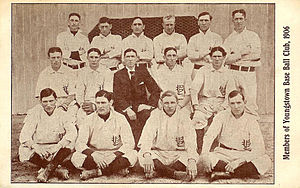
Youngstown Ohio Works (1906), with pitcher Roy Castleton seated in second row, second from left
The Youngstown Ohio Works baseball team was a minor league club that was known for winning the premier championship of the Ohio–Pennsylvania League in 1905, and for launching the professional career of pitcher Roy Castleton a year later. A training ground for several players and officials who later established careers in Major League Baseball, the team proved a formidable regional competitor and also won the 1906 league championship.
During its brief span of activity, the Ohio Works team faced challenges that reflected common difficulties within the Ohio–Pennsylvania League, including weak financial support for teams. Following a dispute over funding, the team's owners sold the club to outside investors, just a few months before the opening of the 1907 season. (Full article...)
General images - load new batch
-
Image 1In May 2010, the Philadelphia Phillies' Roy Halladay pitched the 20th major league perfect game. That October, he pitched only the second no-hitter in MLB postseason history. (from History of baseball)
-
Image 2Cover of Official Base Ball Rules, 1921 edition, used by the American League and National League (from Baseball rules)
-
Image 3The NL champion New York Giants baseball team, 1913. Fred Merkle, sixth in line, had committed a baserunning gaffe in a crucial 1908 game that became famous as Merkle's Boner. (from History of baseball)
-
Image 4The typical motion of a right-handed pitcher (from Baseball rules)
-
Image 61906 World Series, infielders playing "in" for the expected bunt and the possible play at the plate with the bases loaded (from Baseball rules)
-
Image 7A first baseman receives a pickoff throw, as the runner dives back to first base. (from Baseball)
-
Image 8A runner sliding into home plate and scoring. (from Baseball)
-
Image 9Baseball games sometimes end in a walk-off home run, with the batting team usually gathering at home plate to celebrate the scoring of the winning run(s). (from Baseball rules)
-
Image 10The strike zone determines the result of most pitches, and varies in vertical length for each batter. (from Baseball)
-
Image 11Diagram of a baseball field Diamond may refer to the square area defined by the four bases or to the entire playing field. The dimensions given are for professional and professional-style games. Children often play on smaller fields. (from Baseball)
-
Image 12A game from the Cantigas de Santa Maria, c. 1280, involving tossing a ball, hitting it with a stick and competing with others to catch it (from History of baseball)
-
Image 13A well-worn baseball (from Baseball)
-
Image 14Rickey Henderson—the major leagues' all-time leader in runs and stolen bases—stealing third base in a 1988 game (from Baseball)
-
Image 15Japanese-Americans spectating a World War II-era game while in an internment camp. America's ties to immigrants and to Japan have been deeply shaped by a shared baseball heritage. (from History of baseball)
-
Image 17Sadaharu Oh managing the Japan national team in the 2006 World Baseball Classic. Playing for the Central League's Yomiuri Giants (1959–80), Oh set the professional world record for home runs with 868. (from History of baseball)
-
Image 18The American Tobacco Company's line of baseball cards featured shortstop Honus Wagner of the Pittsburgh Pirates from 1909 to 1911. In 2007, the card shown here sold for $2.8 million. (from Baseball)
-
Image 19Jackie Robinson in 1945, with the era's Kansas City Royals, a barnstorming squad associated with the Negro American League's Kansas City Monarchs (from History of baseball)
-
Image 20An Afghan girl playing baseball in August 2002 (from Baseball)
-
Image 21Two players on the baseball team of Tokyo, Japan's Waseda University in 1921 (from Baseball)
-
Image 222013 World Baseball Classic championship match between the Dominican Republic and Puerto Rico, March 20, 2013 (from Baseball)
-
Image 23Fenway Park, home of the Boston Red Sox. The Green Monster is visible beyond the playing field on the left. (from Baseball)
-
Image 24The strike zone, which determines the outcome of most pitches, varies in vertical length depending on the batter's typical height while swinging. (from Baseball rules)
-
Image 28A New York Yankees batter (Andruw Jones) and a Boston Red Sox catcher at Fenway Park (from Baseball)
-
Image 29The standard fielding positions (from Baseball rules)
-
Image 30Pick-off attempt on runner (in red) at first base (from Baseball rules)
-
Image 33Cy Young—the holder of many major league career marks, including wins and innings pitched, as well as losses—in 1908. MLB's annual awards for the best pitcher in each league are named for Young. (from Baseball)
-
Image 34Pitchers are generally substituted during mound visits (team gatherings at the pitcher's mound). (from Baseball rules)
-
Image 35Jackie Robinson in 1945, with the era's Kansas City Royals, a barnstorming squad associated with the Negro American League's Kansas City Monarchs (from Baseball)
-
Image 36A pitcher handing off the ball after being taken out of the game during a mound meeting. (from Baseball)
-
Image 37Baserunners generally stand a short distance away from their base between pitches, preparing themselves to either go back or steal the next base. (from Baseball rules)
-
Image 38A batter follows through after swinging at a pitched ball. (from Baseball rules)
-
Image 40By the 1860s Civil War, baseball (bottom) had overtaken its fellow bat-and-ball sport cricket (top) in popularity within the United States. (from History of baseball)
-
Image 41Sadaharu Oh managing the Japan national team in the 2006 World Baseball Classic. Playing for the Central League's Yomiuri Giants (1959–80), Oh set the professional world record for home runs. (from Baseball)
-
Image 42Pesäpallo, a Finnish variation of baseball, was invented by Lauri "Tahko" Pihkala in the 1920s, and after that, it has changed with the times and grown in popularity. Picture of Pesäpallo match in 1958 in Jyväskylä, Finland. (from Baseball)
-
Image 44Alexander Cartwright, father of modern baseball (from History of baseball)
-
Image 45Defensive positions on a baseball field, with abbreviations and scorekeeper's position numbers (not uniform numbers) (from Baseball)
 Good articles - load new batch
Good articles - load new batch
-
Image 1Vern Donald Freiburger (December 19, 1923 – February 27, 1990) was an American Major League Baseball first baseman who played in two games for the Cleveland Indians on September 6 and September 15 during the 1941 season. At 17 years of age, he was the youngest player to appear in an American League game that season.
Born in Michigan, Freiburger was signed by the Cleveland Indians organization while still in high school. He played one season of minor league baseball, then was given a tryout on the major league roster. After spending 1942 in the minor leagues, he enlisted with the United States Navy to serve in World War II. Upon returning from military service, he returned to the minor leagues, but was no longer considered a major prospect for the Indians, and he proceeded to play in mostly the lower level minor leagues until 1952. Freiburger then retired to California and died in 1990. (Full article...) -
Image 2Diekman with the Philadelphia Phillies in 2012
Jacob Tanner Diekman (born January 21, 1987) is an American professional baseball pitcher who is a free agent. He has previously played in Major League Baseball (MLB) for the Philadelphia Phillies, Texas Rangers, Arizona Diamondbacks, Kansas City Royals, Oakland Athletics, Boston Red Sox, Chicago White Sox, Tampa Bay Rays, and New York Mets.
With the Phillies, Diekman began as a starting pitcher and progressed through a few levels of the Phillies' farm system in his first two years in that role, before adjusting his mechanics and lowering his arm slot to throw sidearm out of the bullpen, as a relief pitcher. The adjustment worked and helped him move through the remaining levels of the Phillies' farm system. In 2012, Diekman made his major league debut. Over the next two seasons, he split time between the major league Phillies and their Triple-A affiliate, the Lehigh Valley IronPigs, though while he was with the major league team, he was considered one of the "lone bright spots" in both 2012 and 2013. Diekman throws a fastball in the upper-90s (mph), a slider, and an occasional changeup. (Full article...) -
Image 3

Joe Hicks Tipton (February 18, 1922 – March 1, 1994) was an American professional baseball player. He played as a catcher in Major League Baseball (MLB) from 1948 through 1954 with the Cleveland Indians, Chicago White Sox, Philadelphia Athletics, and the Washington Senators. In 417 career games, Tipton recorded a batting average of .236 and accumulated 29 home runs, and 125 runs batted in (RBI).
Born and raised in Georgia, Tipton played amateur baseball until the Cleveland Indians signed him. He spent two years in the minor leagues before serving in World War II. He played two more years in the minor leagues upon his return, then made his MLB debut with the Indians in 1948. The Indians traded him to the White Sox in 1949, then the White Sox sent him to the Philadelphia Athletics in 1950. Tipton spent two and a half years with the Athletics before returning to Cleveland. After spending a season with the Washington Senators, he played and managed in the minor leagues for a few seasons before being banned from the minor leagues. After the ban, he moved to Birmingham, Alabama where he died in 1994. (Full article...) -
Image 4

Thomas Virgil Sturdivant (April 28, 1930 – February 28, 2009), nicknamed "Snake", was an American pitcher who played for the New York Yankees, Kansas City Athletics, Boston Red Sox, Washington Senators, Pittsburgh Pirates, Detroit Tigers, and New York Mets of Major League Baseball. He threw a curveball and a knuckleball, among other pitches. He batted left-handed but threw right-handed.
Sturdivant was originally signed by the Yankees as an infielder in 1948. After a two-year stint in the United States Army, he became a pitcher in order to improve his chances of making the major leagues. He debuted with the Yankees in 1955, the first of four straight years he was on a World Series roster. In 1956, he had a 16–8 record, led the American League (AL) with a 2.12 strikeout-to-walk ratio, and won Game 4 of the 1956 World Series, which the Yankees won in seven games over the Brooklyn Dodgers. He went 16–6 in 1957, tying for the AL lead in winning percentage with a .727 mark. Arm trouble and a spike wound to the heel limited him in 1958, though he won his second World Series as the Yankees defeated the Milwaukee Braves in seven games. (Full article...) -
Image 5Roepke pictured in The Mansfield News, 1927
John Peter Roepke (December 28, 1905 – February 26, 1962) was an American football halfback who played one season in the National Football League (NFL) for the Frankford Yellow Jackets as well as four seasons in minor leagues with the Atlantic City Tornadoes, Clifton Heights Orange & Black, Upper Darby Greenbacks, and Paterson Night Hawks. A native of New Jersey, he attended Penn State University, playing football, baseball, and basketball before graduating in 1928. He was selected to the College Football All-America Team following his senior season of 1927. Roepke also briefly played professional baseball for the Scranton Miners in 1928. (Full article...) -
Image 6Jonathan Brian Weber (born January 20, 1978, in Lakewood, California) is an American former professional baseball player. An outfielder, Weber batted and threw left-handed. Considered a journeyman throughout his career, Weber played professionally in minor and independent league baseball from 1999 to 2015. Weber also competed for the United States national baseball team, winning the gold medal at the 2009 Baseball World Cup. (Full article...)
-
Image 7
Cody Joseph Ross (born December 23, 1980), nicknamed "Toy Cannon" and "Ross the Boss," is an American former professional baseball outfielder. He played in Major League Baseball (MLB) for 12 seasons; with the Detroit Tigers (2003), Los Angeles Dodgers (2005–2006), Cincinnati Reds (2006), Florida Marlins (2006–2010), San Francisco Giants (2010–2011), Boston Red Sox (2012), Arizona Diamondbacks (2013–2014) and Oakland Athletics (2015). Ross won a World Series with the San Francisco Giants in 2010. He is one of the few Major League players to bat right-handed and throw left-handed.
Following high school, Ross embarked on his professional career, getting selected by the Detroit Tigers in the fourth round of the 1999 Major League Baseball draft. He reached the Major Leagues in 2003, but suffered a torn ACL which caused him to miss most of September. He was traded to the Los Angeles Dodgers following spring training in 2004, appearing in a handful of games with them in 2005. In 2006, he played for the Los Angeles Dodgers, the Cincinnati Reds, and the Florida Marlins. It was in Florida that he finally established himself, as he played with the Marlins through 2010. He was used mainly as a reserve outfielder in 2006 and 2007, but during the 2008 season he took over a starting role. He would be a starting outfielder for the rest of his Marlins career, playing center field or right field. In 2009, he hit a career-high 24 home runs and won the Marlins' Charlie Hough Good Guy award. (Full article...) -
Image 8
Clinton Dawson Courtney (March 16, 1927 – June 16, 1975), nicknamed "Scrap Iron", was an American professional baseball catcher who played in Major League Baseball (MLB) for the New York Yankees (1951), St. Louis Browns / Baltimore Orioles (1952–1954, 1960, 1961), Chicago White Sox (1955), Washington Senators (1955–1959) and Kansas City Athletics (1961). He batted left-handed and threw right-handed.
Courtney was born in Louisiana, growing up there and in Arkansas. After serving in the United States Army during World War II, he was signed as a catcher by the New York Yankees. Playing minor league baseball for them for the next few seasons, he was involved in several fights. After one game with the Yankees in 1951, he was traded to the Browns in 1952 at the urging of Rogers Hornsby, St. Louis's manager. Courtney won The Sporting News American League Rookie of the Year, batting .286. Both that season and the next, he was involved in on-the-field fights with Billy Martin, whom he had battled in the minor leagues several seasons before. Courtney remained the starting catcher for the Browns when they moved to Baltimore in 1954 and became the Orioles. Then, he was traded to the White Sox. (Full article...) -
Image 9Casilla at the 2012 World Series victory parade
Santiago Casilla (born July 25, 1980) is a Dominican former professional baseball relief pitcher. He played in Major League Baseball (MLB) from 2004 to 2018 for the Oakland Athletics and San Francisco Giants. Casilla threw four pitches: a fastball, slider, curveball, and changeup.
Casilla originally signed with Oakland under the name of Jairo Garcia, listing his birthdate as 1983. He debuted with Oakland in 2004, pitching briefly for them that year and the next. In January 2006, he revealed his true name and age. 2007 marked the first time he pitched more than four games in a year for Oakland; he an initial boost to their bullpen but missed the latter part of the season with an injury. He appeared in 51 games in 2008, then was allowed to become a free agent after posting a 5.96 earned run average (ERA) in 2009. (Full article...) -
Image 10
Jayson Richard Gowan Werth (born May 20, 1979) is an American former professional baseball outfielder who played in Major League Baseball (MLB) from 2002 to 2017. His 15-season career was split among the Toronto Blue Jays, Los Angeles Dodgers, Philadelphia Phillies, and the Washington Nationals.
Born in Springfield, Illinois, Werth was a third-generation baseball player, as his great-grandfather and grandfather had both played professional baseball, as had his uncle and stepfather. His time catching for Glenwood High School led to an athletic scholarship to play college baseball with the Georgia Bulldogs, which he turned down after the Baltimore Orioles selected him in the 1997 MLB Draft. Werth played in the Orioles' farm system until 2001, when he was traded to the Blue Jays as part of a package for John Bale. Werth made his MLB debut with the Blue Jays in 2002, and split time between the majors and minors until he was traded to the Dodgers in 2004. (Full article...) -
Image 11

Rector v. Major League Baseball Advanced Media, No. 303630 (N.Y. Sup. Bronx Co. 2014), was a New York Supreme Court defamation case. Andrew Rector sued Major League Baseball, the New York Yankees, ESPN and their MLB announcers for broadcasting images of him sleeping at a game at Yankee Stadium between the New York Yankees and the Boston Red Sox and allegedly making defamatory comments about him. Rector sued for $10 million for "defamation and intentional infliction of emotional distress". The case was dismissed by Judge Julia Rodriguez, who ruled that the statements made were not defamatory. (Full article...) -
Image 12
Russell Oles Branyan (born December 19, 1975) is an American former professional baseball first baseman, who played in Major League Baseball (MLB) for the Cleveland Indians (two occasions), Cincinnati Reds, Milwaukee Brewers (two occasions), Tampa Bay Devil Rays, San Diego Padres, Philadelphia Phillies, St. Louis Cardinals, Seattle Mariners (two occasions), Arizona Diamondbacks, and Los Angeles Angels of Anaheim. He batted left-handed and threw right-handed. While primarily a first baseman, Branyan was capable of playing third base and the outfield, as well.
Branyan began his professional career in the Cleveland Indians minor league system. He made his big league debut with the Indians, on September 26, 1998, and was ranked the Indians' top prospect in 1999 by Baseball America. Though he demonstrated the ability to hit home runs with Cleveland, his batting average was low. Indians' manager Charlie Manuel suggested in 2002 that Branyan could benefit from more playing time, but he was traded to the Reds for prospect Ben Broussard during the season. Excited to have a "clean slate," as he put it, Branyan hit 16 home runs with the Reds in 2002 but struggled with injuries in the 2003 campaign. Allowed to become a free agent, he spent 2004 in the minor leagues for the Atlanta Braves and Cleveland before Milwaukee picked him up on July 26. In 51 games for the Brewers, Branyan hit 11 home runs. He competed with Wes Helms for the starting spot at third base in 2005 but again battled injuries much of the season. Branyan signed with the Devil Rays in 2006 and spent most of the year on their roster, but he expressed concern at the fact that he was not an everyday player with Tampa Bay. Traded to the Padres in August, he hit what was at the time the longest home run in Petco Park history, measured at 453 feet. He batted .197 for the Padres in 2007 and was released July 28. Branyan spent brief stints with the Phillies and Cardinals that season before becoming a free agent at the end of the year. (Full article...) -
Image 13
William Louis Raimondi (December 1, 1912 – October 18, 2010) was an American professional baseball catcher. He played in Minor League Baseball for 22 years, including 21 years in the Pacific Coast League (PCL). He played for the Oakland Oaks from 1932 to 1949, the Sacramento Solons from 1949 to 1950, and the Los Angeles Angels from 1951 to 1953. Raimondi is a member of the PCL Hall of Fame, elected in 1951.
Raimondi was born and raised in the San Francisco Bay Area. After a standout baseball career at McClymonds High School in Oakland, California, Raimondi signed with the Oaks of the PCL. He tried out with the Cincinnati Reds for the 1936 season, but an arm injury prevented him from playing in Major League Baseball (MLB). Raimondi returned to the Oaks in 1937, and declined further opportunities from MLB clubs to stay close to home. He served as the interim manager of the Oaks during the 1945 season. A year after winning the PCL championship with the 1948 Oaks under Casey Stengel, Chuck Dressen traded Raimondi to Sacramento, where he became a player-coach during the 1950 season. Signing with the Angels in 1951, Raimondi served as a backup catcher and coach through the 1953 season, when he retired. (Full article...) -
Image 14Emmett Watson (November 22, 1918 – May 11, 2001) was an American newspaper columnist from Seattle, Washington, whose columns ran in a variety of Seattle newspapers over a span of more than fifty years. Initially a sportswriter, he is primarily known for authoring a social commentary column for the Seattle Post-Intelligencer (P-I) from 1956 until 1982, when he moved to The Seattle Times and continued there as a columnist until shortly before his death in 2001.
Watson grew up in Seattle during the 1920s and 1930s. He was a tireless advocate, through his column as well as through a fictional organization he created called Lesser Seattle, for limiting the seemingly unbridled growth and urban renewal that dramatically altered the city's landscape during the second half of the twentieth century. (Full article...) -
Image 15
Mark Steven Gubicza (/ˈɡʊbɪzə/; born August 14, 1962), nicknamed "Gubie", is an American former professional baseball pitcher and sportscaster. Gubicza played in Major League Baseball (MLB) for the Kansas City Royals (1984–96) and Anaheim Angels (1997). He is a color commentator for Los Angeles Angels games on Bally Sports West.
After being drafted out of William Penn Charter School in the second round of the 1981 MLB draft and playing three seasons in the minor leagues, Gubicza spent nearly all of his MLB career with the Royals, making all but two of his career appearances with the team. He was a mainstay in the Royals starting rotation for years, earning back-to-back MLB All-Star selections in 1988 and 1989 and making an Opening Day start for the team in 1989. Gubicza played a reduced number of games later in his career due to three arm injuries and a leg injury between 1990 and 1997. He was traded to the Anaheim Angels before the 1997 season and retired after that year. (Full article...)
Did you know (auto-generated) - load new batch

- ... that a painting by Major League Baseball player Gene Locklear was hung in the White House?
- ... that Julie Croteau is credited as being the first woman to play National Collegiate Athletic Association men's college baseball?
- ... that Devin Futrell used a post to dodge a draft?
- ... that baseball player Joey Marciano is a cousin of world heavyweight champion Rocky Marciano?
- ... that Larry Kennedy played professional baseball while serving as his town's mayor?
- ... that Helene Hathaway Britton, the first woman to own a Major League Baseball team, was unsuccessfully pressured by other club owners to sell the team?
- ... that Gaylord Perry admitted that he had cheated in baseball in his autobiography Me and the Spitter?
- ... that Mark Hutton was the first Australian to be a starting pitcher in a Major League Baseball game?
Quotes
| I'm done trying to figure [...] out [what went wrong]. The more I try to figure them out, the bigger headache I get. |
 Featured lists - load new batch
Featured lists - load new batch
-
Image 1Lou Piniella won the 2008 National League Manager of the Year Award, and won twice in the American League.
In Major League Baseball, the Manager of the Year Award is an honor given annually since 1983 to two outstanding managers, one each in the American League (AL) and the National League (NL). The winner is voted on by 30 members of the Baseball Writers' Association of America (BBWAA). Each submits a vote for first, second, and third place among the managers of each league.[a] The manager with the highest score in each league wins the award.
Several managers have won the award in a season in which they led their team to 100 or more wins. They are:- Lou Piniella – 116 (Seattle Mariners, 2001)
- Joe Torre – 114 (New York Yankees, 1998)
- Gabe Kapler – 107 (San Francisco Giants, 2021)
- Sparky Anderson – 104 (Detroit Tigers, 1984)
- Tony La Russa – 104 (Oakland Athletics, 1988)
- Dusty Baker – 103 (San Francisco Giants, 1993)
- Larry Dierker – 102 (Houston Astros, 1998)
- Whitey Herzog – 101 (St. Louis Cardinals, 1985)
- Rocco Baldelli – 101 (Minnesota Twins, 2019)
- Buck Showalter – 101 (New York Mets, 2022)
- Brandon Hyde – 101 (Baltimore Orioles, 2023)
- Kevin Cash – 100 (Tampa Bay Rays, 2021)
-
Image 2

Don Larsen threw the only perfect game ever in MLB postseason play.
The New York Yankees are a Major League Baseball franchise based in the New York City borough of The Bronx. Also known in their early years as the "Baltimore Orioles" (1901–02) and the "New York Highlanders" (1903–1912), the Yankees have had twelve pitchers throw thirteen no-hitters in franchise history. A no-hitter is officially recognized by Major League Baseball only "...when a pitcher (or pitchers) allows no hits during the entire course of a game, which consists of at least nine innings. In a no-hit game, a batter may reach base via a walk, an error, a hit by pitch, a passed ball or wild pitch on strike three, or catcher's interference". No-hitters of fewer than nine complete innings were previously recognized by the league as official; however, several rule alterations in 1991 changed the rule to its current form. Four perfect games, a special subcategory of no-hitter, have been pitched in Yankees history. As defined by Major League Baseball, "in a perfect game, no batter reaches any base during the course of the game." This feat was achieved by Don Larsen in 1956, David Wells in 1998, David Cone in 1999, and Domingo German in 2023. Wells later claimed he was a "little hung-over" while throwing his perfect game.
George Mogridge threw the first no-hitter in Yankees history, beating their rival Boston Red Sox 2–1, their only no-hitter in which the opposition scored. Their most recent no-hitter was Domingo Germán's perfect game against the Oakland Athletics during the 2023 season on June 28. The Yankees' first perfect game was also thrown by a right-handed pitcher, Don Larsen, and came in Game 5 of the 1956 World Series. Larsen's perfect game was the only no-hitter in MLB postseason play until Roy Halladay of the Philadelphia Phillies pitched a no-hitter in Game 1 of the 2010 National League Division Series. Coincidentally, David Cone's perfect game came on "Yogi Berra Day" at Yankee Stadium. Berra had caught Larsen's perfect game and both he and Larsen were in the stands for the game. Of the twelve no-hitters pitched by Yankees players, three each have been won by the scores 4–0 and 2–0, more common than any other result. The largest margin of victory in a Yankees no-hitter was 13 runs in a 13–0 win by Monte Pearson. German's perfect game represented the second largest margin of victory in a Yankees no-hitter, as the Yankees defeated the Athletics 11–0 in the 24th perfect game in MLB history. (Full article...) -
Image 3
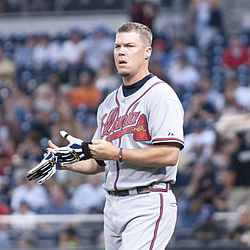
Chipper Jones won the National League MVP Award in 1999, four years after winning a World Series ring.
The Atlanta Braves are a Major League Baseball (MLB) franchise based in Atlanta, Georgia. They play in the National League East division. Officially known as the "First-Year Player Draft", the Rule 4 Draft is MLB's primary mechanism for assigning players from high schools, colleges, and other amateur clubs to its franchises. The draft order is determined based on the previous season's standings, with the team possessing the worst record receiving the first pick. In addition, teams which lost free agents in the previous off-season may be awarded compensatory or supplementary picks. Since the establishment of the draft in 1965, the Braves have selected 56 players in the first round.
Of those 56 players, 27 have been pitchers, the most of any position; 15 of these were right-handed, while 12 were left-handed. The Braves have also selected eight outfielders, seven shortstops, five catchers, four third basemen, three first basemen, and two second basemen in the initial round of the draft. The franchise has drafted nine players from colleges or high schools in the state of Florida, more than any other state. Eight more selections have come from their home state of Georgia. Two selections have come from outside the 50 United States: Luis Atilano (2003) is from the Commonwealth of Puerto Rico, and Scott Thorman (2000) is from Ontario, Canada. (Full article...) -
Image 4
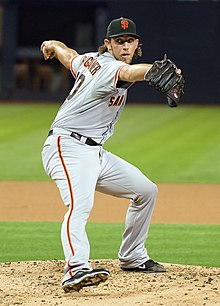
Madison Bumgarner, the 2014 National League Championship Series Most Valuable Player, won both this award and the World Series MVP in the same season.
The League Championship Series Most Valuable Player (MVP) Award is given annually to the Major League Baseball (MLB) players deemed to have the most impact on their teams' performances in each of the two respective League Championship Series that comprise the penultimate round of the MLB postseason. The award is given separately for a player in both the American League Championship Series and the National League Championship Series. It has been presented in the National League (NL) since 1977, and in the American League (AL) since 1980. Dusty Baker won the inaugural award in 1977 with the Los Angeles Dodgers, and Frank White won the first AL award in 1980 with the Kansas City Royals. The eleven Hall of Famers to win LCS MVPs include Roberto Alomar, George Brett, Dennis Eckersley, Rickey Henderson, David Ortiz, Kirby Puckett, Ozzie Smith, Willie Stargell, John Smoltz, Iván Rodríguez, and Mariano Rivera.
Three players have won the award twice: Steve Garvey (1978, 1984), Dave Stewart (1990, 1993), and Orel Hershiser (1988, 1995). Incidentally, all three of these players won their two awards with two different teams. Nine players have gone on to win the World Series MVP Award in the same season in which they won the LCS MVP—eight from the NL and one from the AL. Three players have won while playing for the losing team in the series: Fred Lynn played for the 1982 California Angels; Mike Scott pitched for the 1986 Houston Astros; and Jeffrey Leonard played for the 1987 San Francisco Giants. Two players have shared the award in the same year three times, all in the NL; Rob Dibble and Randy Myers for the 1990 Cincinnati Reds, the Chicago Cubs' Jon Lester and Javier Báez in 2016, and Chris Taylor and Justin Turner of the Los Angeles Dodgers in 2017. (Full article...) -
Image 5

Robin Yount (1973) is one of two Brewers first-round picks to be inducted in the National Baseball Hall of Fame.
The Milwaukee Brewers are a Major League Baseball (MLB) franchise based in Milwaukee, Wisconsin. They play in the National League Central division. Established in Seattle, Washington, as the Seattle Pilots in 1969, the team became the Milwaukee Brewers after relocating to Milwaukee in 1970. The franchise played in the American League until 1998, when it moved to the National League in conjunction with a major league realignment. Since the institution of MLB's Rule 4 draft, the Brewers have selected 69 players in the first round. Officially known as the "First-Year Player Draft", the Rule 4 draft is MLB's primary mechanism for assigning players from high schools, colleges, and other amateur clubs to its franchises. The draft order is determined based on the previous season's standings, with the team possessing the worst record receiving the first pick. In addition, teams which lost free agents in the previous off-season may be awarded compensatory or supplementary picks.
Of the 71 players picked in the first round by Milwaukee, 28 have been pitchers, the most of any position; 18 of these were right-handed, while 10 were left-handed. Fifteen outfielders, 13 shortstops, 5 third basemen, 4 first basemen, 3 catchers, and 3 second basemen were also taken. Fifteen of the players came from high schools or universities in the state of California, and Florida follows with ten players. (Full article...) -
Image 6

Derek Jeter (1992) has won five World Series titles with the New York Yankees, and was the Rookie of the Year in 1996.
The New York Yankees are a Major League Baseball (MLB) franchise based in The Bronx, New York. They play in the American League East division. Since the institution of Major League Baseball's Rule 4 Draft, the Yankees have selected 46 players in the first round. Officially known as the "First-Year Player Draft", the Rule 4 Draft is Major League Baseball's primary mechanism for assigning amateur baseball players from high schools, colleges, and other amateur baseball clubs to its teams. The draft order is determined based on the previous season's standings, with the team possessing the worst record receiving the first pick. In addition, teams which lost free agents in the previous off-season may be awarded compensatory or supplementary picks.
Of the 48 players the Yankees have selected in the first round, 23 were pitchers. Of these, 18 were right-handed and 5 were left-handed. The Yankees have drafted ten outfielders, six shortstops, three catchers, three first basemen, and three third basemen. The team has never drafted a player at second base. The Yankees drafted 29 players out of high school, and drafted 18 players out of college. Eleven of the players came from high schools or colleges in the state of California, and Florida follows with five players. (Full article...) -
Image 7

1891 Athletics manager Bill Sharsig
The Philadelphia Athletics were a professional baseball team that existed for two seasons from 1890 to 1891. Known alternatively as the Philadelphia Quakers, and sometimes informally as "Buffinton's Beauties", they played their first season in the newly created Players' League (PL) of 1890, and were managed by Jim Fogarty and Charlie Buffinton. After the demise of the PL following the 1890 season, the team joined the American Association (AA) for the 1891 season, and were managed by Bill Sharsig and George Wood. For each season, the franchise used Forepaugh Park as their home field.
Despite the existence of established major league representation in Philadelphia, the Phillies of the National League (NL) and the Athletics of the AA, the new PL franchise was able to sign veteran players, including Buffinton, Billy Shindle, George Wood, and Ben Sanders. The Quakers finished the season with a 68–63 win–loss record, with one tie, placing them fifth among the eight PL teams. (Full article...) -
Image 8In baseball, earned run average (ERA) is a statistic used to evaluate pitchers, calculated as the mean of earned runs given up by a pitcher per nine innings pitched.[a] A pitcher is men by a baserunner who reached base while batting against that pitcher, whether by hit, base on balls or "walk", or being hit by a pitched ball; an earned run can be charged after the pitcher is relieved if he allows the runner before leaving the game. Runs scored by players who reach base on errors, passed balls, or catcher interference under special circumstances are treated as unearned runs, and do not count towards the pitcher's ERA.
Major League Baseball recognizes the player in each league[b] with the lowest earned run average each season.[c] The first ERA champion in the National League was George Bradley; in the National League's inaugural 1876 season, Bradley posted a 1.23 ERA for the St. Louis Brown Stockings, allowing 78 earned runs in 573 innings pitched. The American League was established in 1901, and Hall of Fame pitcher Cy Young led that league with a 1.62 ERA for the Boston Americans during the 1901 season. (Full article...) -
Image 9
Major League Baseball (MLB) annually honors its best relief pitchers in the American League (AL) and National League (NL) with the Mariano Rivera AL Reliever of the Year Award and Trevor Hoffman NL Reliever of the Year Award, respectively. The awards are named after former relievers Mariano Rivera and Trevor Hoffman, who played their entire careers in the respective leagues. First issued in 2014, the awards replaced the Delivery Man of the Year Award, which had been presented since 2005.
The Reliever of the Year Awards are based on the votes of a panel of retired relievers. Each voter selects three pitchers for each league based solely on their performance in the regular season; a 5-3-1 weighted point system is used to determine the winner. At its inception in 2014, the panel consisted of the top five relievers in career saves at the time—Rivera, Hoffman, Lee Smith, John Franco, and Billy Wagner—and the four living relief pitchers who were in the Hall of Fame: Dennis Eckersley, Rollie Fingers, Goose Gossage, and Bruce Sutter. (Full article...) -
Image 10The Cleveland Guardians (formerly known as the Indians) are a professional baseball franchise based in Cleveland, Ohio that formed in 1901. They are members of the Central division of Major League Baseball's American League. The current manager of the Guardians is Stephen Vogt, who replaced Terry Francona after he stepped down at the end of the 2023 season.
Cleveland has had 47 managers in their major league history. Jimmy McAleer became the first manager of the then Cleveland Blues in 1901, serving for one season. In 1901, McAleer was replaced with Bill Armour. Cleveland made their first playoff appearance under Tris Speaker in 1920. Out of the eight managers that have led Cleveland into the postseason, only Speaker and Lou Boudreau have led Cleveland to World Series championships, doing so in 1920 and 1948, respectively. Al López (1954), Mike Hargrove (1995 and 1997) and Terry Francona (2016) have also appeared in World Series with Cleveland. The highest winning percentage of any manager who managed at least one season was López, with a percentage of .617. The lowest percentage was Johnny Lipon's .305 in 1971, although he managed for only 59 games. The lowest percentage of a manager with at least one season with Cleveland was McAleer's .397 in 1901. (Full article...) -
Image 11
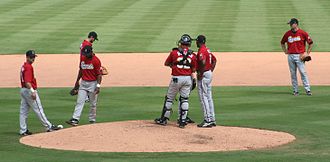
Pitching coach Stan Kyles meets with the Sounds' battery of Justin Lehr and J. C. Boscán on the mound.
The Nashville Sounds Minor League Baseball team has played in Nashville, Tennessee, since being established in 1978 as an expansion team of the Double-A Southern League. They moved up to Triple-A in 1985 as members of the American Association before joining the Pacific Coast League in 1998. With the restructuring of the minor leagues in 2021, they were placed in the Triple-A East, which became the International League in 2022. In the 2024 season, the Sounds' coaching staff was led by manager Rick Sweet and included Al LeBoeuf (hitting), Patrick McGuff (pitching and bullpen), Eric Theisen (hitting), David Tufo (bench), and Ned Yost IV (general).
Six former Sounds players later served as coaches for the team. Wayne Garland of the 1982 starting rotation returned as pitching coach from 1987 to 1988. Don Cooper, who pitched out of the bullpen in 1980, served as pitching coach from 1994 to 1996. Reliever Steve Wilson retired from the Sounds during the 1995 season and became the team's pitching coach. Fred Dabney, a reliever on the 1993 team, returned to coach pitchers from 2012 to 2014. Éric Gagné, who made two major league rehabilitation starts in 2008, served as bullpen coach in 2019. Jim Henderson, a reliever from 2011 to 2012 and in 2014, returned to the Sounds as pitching coach in 2021. Outfielder Gene Roof (1986) and catcher Buddy Pryor (1987) were player-coaches who coached hitting while also playing on the team. Two coaches also managed the Nashville club. Pitching coach Wayne Garland filled in as interim manager for three games in 1988 after the dismissal of manager Jack Lind. Richie Hebner, who was the hitting coach from 1998 to 2000, became the team's manager for the second half of the 2000 season when Trent Jewett was hired as the Pittsburgh Pirates' third base coach. Four coaches have been selected to participate in the Triple-A All-Star Game: Stan Kyles (2006), Rich Gale (2011), Bob Skube (2014), and Rick Rodriguez (2017). (Full article...) -
Image 12The Commissioner's Historic Achievement Award is awarded by the commissioner of baseball, the chief executive of Major League Baseball (MLB), to a group or person who has made a "major impact on the sport" of baseball. It is not an annual award; rather, the Commissioner presents it at his discretion. The trophy is a gold baseball sitting atop a cylindrical silver base, created by Tiffany & Co. The award has been presented sixteen times: thirteen times to players, once to a team, and twice to a non-player. Mark McGwire and Sammy Sosa were the first to receive the award for their parts in the 1998 MLB home run record chase. The most recent recipient is Shohei Ohtani, who was honored in 2021 for being the first player in MLB history to be an All-Star as both a starting pitcher and a lead-off hitter in the 2021 All-Star Game and for completing a two-way season as a hitter and as a pitcher. The 2001 Seattle Mariners won the award as a team for posting a 116–46 record. Roberto Clemente, the 2006 awardee, is the only player to receive the award posthumously; his award was accepted by his wife, Vera.
Three years after McGwire and Sosa were honored, Cal Ripken Jr. and Tony Gwynn, both of whom retired after the 2001 season, received the award and were honored at the 2001 MLB All-Star Game; Ripken was elected to the American League All-Star team as a starter at third base, while Gwynn was later added as an honorary member of the National League team. During the first inning of the game, Alex Rodriguez, who had been elected the starter at shortstop—the position at which Ripken played for most of his career—switched positions with Ripken for the first inning of the game as a tribute. Including the presentation of the award to the Mariners following the season, the 2001 season's three awards are the most presented in a single year. (Full article...) -
Image 13The Pittsburgh Pirates are a Major League Baseball (MLB) franchise based in Pittsburgh, Pennsylvania. They play in the National League Central division. Since the establishment of the Rule 4 Draft the Pirates have selected 72 players in the first round. Officially known as the "First-Year Player Draft", the Rule 4 Draft is MLB's primary mechanism for assigning players from high schools, colleges, and other amateur clubs to its franchises. The draft order is determined based on the previous season's standings, with the team possessing the worst record receiving the first pick. In addition, teams which lost free agents in the previous off-season may be awarded compensatory or supplementary picks.
Of these 72 players, 27 have been pitchers, the most of any position; 20 of these were right-handed, while 7 were left-handed. 17 outfielders and 15 shortstops were selected. The Pirates have also drafted 7 catchers, 3 first basemen, and 3 third basemen, but have never selected a second baseman in the first round. Eleven players came from high schools or universities in the state of California, while eight came from Florida. (Full article...) -
Image 14

Hank Aaron, the holder of ten franchise records for the Braves
The Atlanta Braves are a Major League Baseball (MLB) franchise based in Atlanta. The Braves formed in 1871 as the Boston Red Stockings. After moving in 1953 to Milwaukee for 12 years and a World Series Championship in '57, the Braves relocated to Atlanta in 1966. Through 2010, the Braves have played 20,053 games, winning 9,945, losing 9,954, and tying 154, for a winning percentage of approximately .500. This list documents the superlative records and accomplishments of team members during their tenures in MLB.
Hank Aaron holds the most franchise records as of the end of the 2010 season, with ten, including most career hits, doubles, and the best career on-base plus slugging percentage. Aaron also held the career home runs record from April 8, 1974 until August 8, 2007. He is followed by Hugh Duffy, who holds eight records, including best single-season batting average and the best single-season slugging percentage record. (Full article...) -
Image 15
The Chicago White Sox celebrate after defeating the Minnesota Twins 1–0 to win the 2008 American League Central.
A tie-breaker was required in Major League Baseball (MLB) when two or more teams were tied at the end of the regular season for a postseason position such as a league pennant (prior to the introduction of the League Championship Series in 1969), a division title, or a wild card spot. Until 2022, both the American League (AL) and the National League (NL) used a one-game playoff format for tie-breakers, although the NL used a best-of-three series prior to 1969, when the leagues were split into divisions. As these tie-breaker games counted as part of the regular season and MLB teams (American League beginning in 1961, and National League beginning in 1962) have 162-game regular season schedules, the tie-breaker games were sometimes referred to as "Game 163". In 2022, as part of the new Collective Bargaining Agreement to end the 2021–22 Major League Baseball lockout, tiebreaker games were replaced with statistical tiebreaker procedures.
Sixteen tie-breakers – 12 single-game and four series – have been played in MLB history. In baseball statistics, tie-breaker games counted as regular season games with all events in them counted towards regular season statistics. This had implications on statistical races, such as when Matt Holliday won the batting average and runs batted in titles thanks in part to his performance in the 2007 tie-breaker. Home-field advantage for tie-breakers was determined by a coin flip through the 2008 season, after which performance-based criteria, starting with head-to-head record of the tied teams, were put in place. (Full article...)
More did you know
- ... that the San Francisco Giants drafted Brock Bond when they meant to draft Casey Bond?
- ... that Eddie Gillette led the Wisconsin Badgers football team to an undefeated season and in baseball "beat some of the best pitchers in the 'Three-Eye League'"?
- ... that the 2005 book Baseball Before We Knew It brought new evidence of the origins of baseball into play?
- ... that in baseball, no Gold Glove Award-winning catcher posted an errorless season until Charles Johnson and Mike Matheny accomplished the feat twice in six years?
- ... that Bob "Horse" Reynolds founded the Los Angeles Angels baseball team and was inducted into the College Football Hall of Fame within a year?
- ... that Red Snapp was considered the "king of the minor leagues"?
Sports portals
Selected picture

| Credit: National Photo Company |
Tyrus Raymond "Ty" Cobb (December 18, 1886 – July 17, 1961), nicknamed "The Georgia Peach," was a baseball player and is regarded by some historians and journalists as the best player of the dead-ball era and is generally seen as one of the greatest players of all time. Cobb also received the most votes of any player on the 1936 inaugural Hall of Fame Ballot, receiving 222 out of a possible 226 votes. Cobb is widely credited with setting ninety Major League Baseball records during his career.
Associated Wikimedia
The following Wikimedia Foundation sister projects provide more on this subject:
-
Commons
Free media repository -
Wikibooks
Free textbooks and manuals -
Wikidata
Free knowledge base -
Wikinews
Free-content news -
Wikiquote
Collection of quotations -
Wikisource
Free-content library -
Wikiversity
Free learning tools -
Wiktionary
Dictionary and thesaurus
More portals
- Portals with triaged subpages from June 2018
- All portals with triaged subpages
- Portals with no named maintainer
- Automated article-slideshow portals with 51–100 articles in article list
- Automated article-slideshow portals with 501–1000 articles in article list
- Random portal component with 41–50 available subpages
- Automated article-slideshow portals with 201–500 articles in article list
- Random portal component with 11–15 available subpages
- Random portal component with 21–25 available image subpages


![Image 1 Advertisement in Billboard magazine in 1907 How Brown Saw the Baseball Game is an American short silent comedy film produced in 1907 and distributed by the Lubin Manufacturing Company. The film follows a baseball fan named Mr. Brown who overdrinks before a baseball game and becomes so intoxicated that the game appears to him in reverse motion. During production, trick photography was used to achieve this effect. The film was released in November 1907. It received a positive review in a 1908 issue of The Courier-Journal that reported the film was successful and "truly funny". As of 2021[update], it is unclear whether the print of the film has survived. The identities of the film cast and production crew are unknown. Film historians have noted similarities between the plot of How Brown Saw the Baseball Game and How the Office Boy Saw the Ball Game. It is a comedy film directed by Edwin S. Porter, having released a year before How Brown Saw the Baseball Game. (Full article...)](http://upload.wikimedia.org/wikipedia/en/d/d2/Blank.png)







